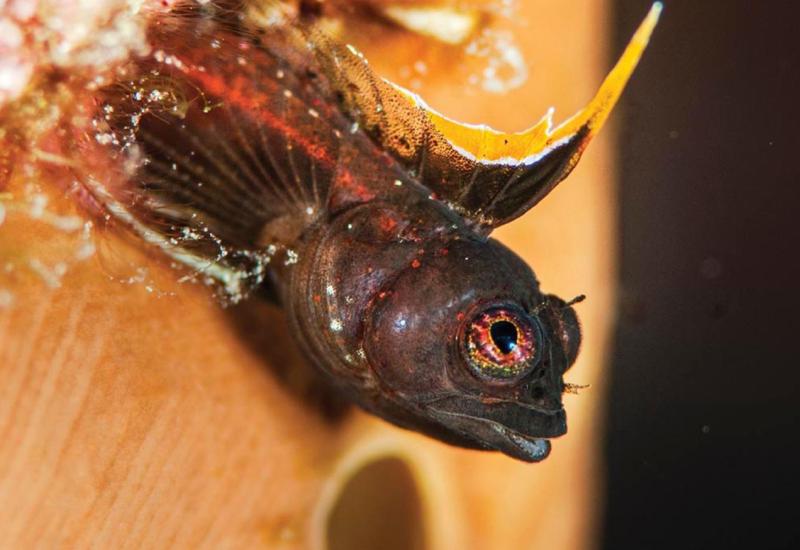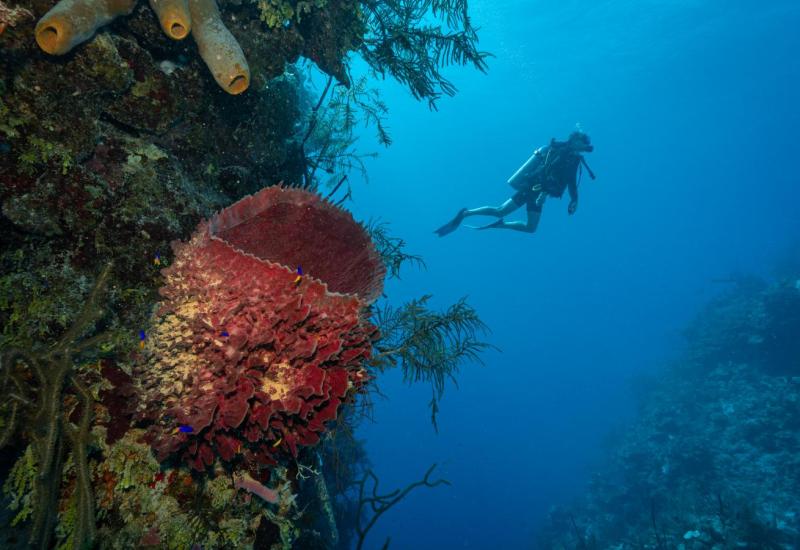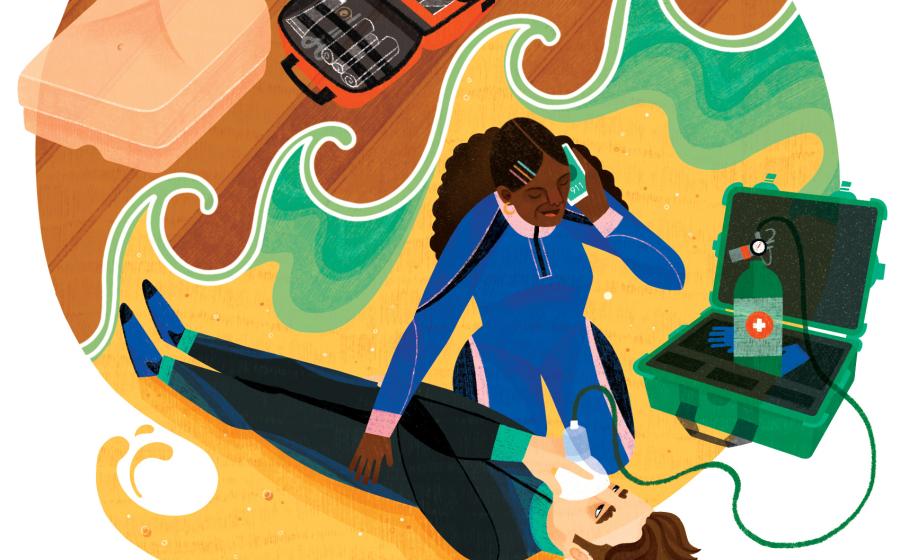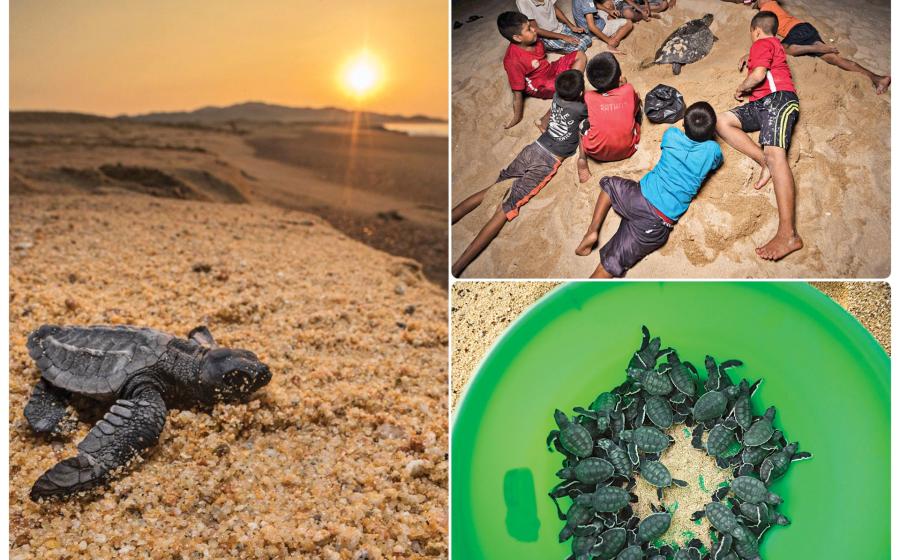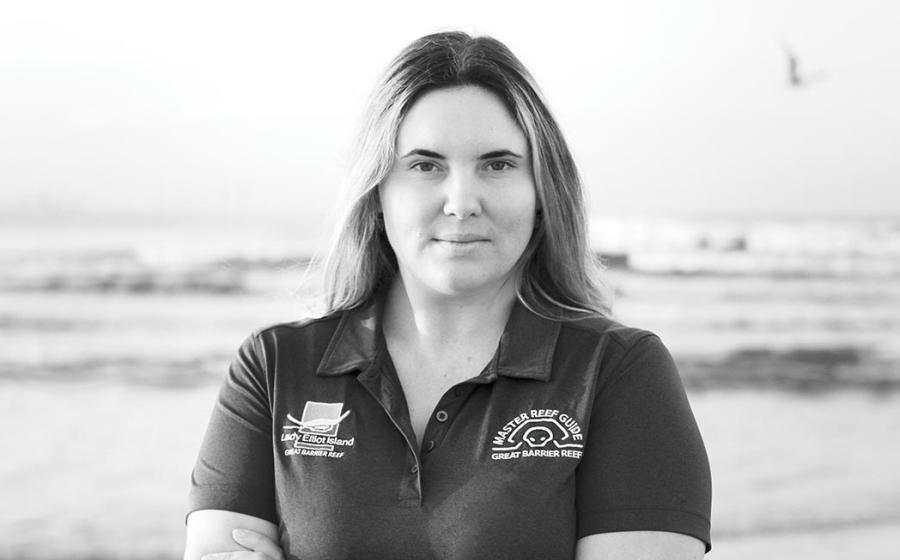Destination Top 10: British Virgin Islands

Baths Beach, Virgin Gorda, British Virgin Islands
Shutterstock
Few Caribbean destinations offer as enticing a mix of topside beauty and unique dive options as the British Virgin Islands. Here you'll find green, mountainous landscapes, convoluted shorelines with idyllic, protected anchorages and captivating underwater topography. And you're never far from a great dive site: lush coral gardens are found on the sloping reefs that surround the islands, seamounts rise from the seafloor, and an underwater armada of wrecks rounds out the offerings. But as good a reason to visit the BVIs as all that fantastic diving is, the islands also seem to inspire a feel-good, no-worries vibe in locals and tourists alike. Here, a guide to the top 10 reasons to make the BVIs your next dive destination.
Funky Tortola
Tortola may be the largest of the British Virgin Islands, the center of tourism and commerce, but it's still a funky little Caribbean outpost where getting away from it all is no problem. Road Town, the capital of the territory, is relatively bustling, especially with its consistent influx of cruise ship passengers, but the mountainous interior of the island is rural, and there are plenty of quiet beaches. Busy marinas can be found on the south coast of the island, and there's no shortage of good restaurants that feature everything from traditional West Indian fare to British pub food to fusion cuisine.
Tortola is also home to more dive operations than any other island in the chain, but there are few sites directly off the island. The majority of established dive sites can be found across the Sir Francis Drake Channel, around the largely unpopulated islands that separate the channel from the open Caribbean: Peter, Norman, Cooper, Salt, Ginger and Dead Chest.
Laid-back Virgin Gorda
While the pace of life on Tortola is not what anyone would call frenetic, the second-largest island in the BVIs is even more relaxed. Shaped vaguely like a bat with wings outstretched, Virgin Gorda consists of two land masses joined by a strip of land. At the northern end of the island you'll find North Sound, a favorite anchorage for sailors and the location of several resorts. At the southern end are several picturesque beaches, including the island's leading attraction, the Baths. Along this world-famous beach, a scattering of colossal granite boulders forms quiet grottoes and pools, perfect for snapping photos guaranteed to induce the envy of folks back home. Bring snorkel and fins to swim with a colorful array of reef fish on the ocean side of the rocks. To avoid crowds, visit the Baths in the morning or late afternoon, or visit one of the nearby beaches — Spring Bay or Little Trunk Bay — that boast similar topography and fewer visitors.
Divers staying on Virgin Gorda have easy access to sites surrounding the nearby Dog Islands, which are marked by intriguing underwater topography including arches and canyons.
Good-Time Jost van Dyke
Not much diving is done from Jost van Dyke, a small getaway northwest of Tortola, but that's no reason to stay away. This mountainous island is popular among boaters for having perfected the idea of the beachside bar. There are a number of them here, with Foxy's Tamarind Bar leading the way. Proprietor Foxy Callwood runs the sand-floor establishment and provides the entertainment, playing guitar and singing. Foxy's is also known for hosting legendary Halloween and New Year's parties. (Jost Van Dyke is also the ideal place to try a Painkiller, the ubiquitous concoction of rum, pineapple juice, orange juice and cream of coconut, that has become the unofficial drink of the BVIs.) Sail over to Jost van Dyke or catch a ferry from Tortola for an afternoon of laid-back fun.
The Wreck of the Chikuzen
The Rhone might be the BVIs' most popular wreck among divers, but large schools of fish and big pelagics seem to prefer the wreck of the Chikuzen, nine miles northwest of Virgin Gorda. This wreck site is remote and subject to unfavorable ocean conditions, so it's not dived as often as most other sites. But if you have a window of opportunity and a dive operator willing to make the run out to the ship, take it. Lying on its port side on a sand plain in as much as 80 feet of water, the 246-foot refrigeration ship is a magnet for marine life including vast aggregations of snappers, grunts and jacks as well as schooling barracudas. In addition to the regular schools, keep an eye out for visiting pelagics like sharks, cobia and spotted eagle rays.
Seamounts
Many of the most interesting dive sites in the British Virgin Islands are anomalies on the seafloor — remnants of the violent volcanic upheaval that formed these islands. Because they're not usually in the close lee of an island, seamounts here can be subject to less favorable sea conditions than the typical reef sites. But the payoff for making the trip is complex underwater topography and phenomenal marine life.
One of the best seamount sites is Blonde Rock, which rises from 60 feet to within 15 feet of the surface between Salt and Dead Chest islands. The rock itself is heavily honeycombed, with ledges and overhangs sheltering blackbar soldierfish, glasseye snapper and fairy basslets. Dog snapper and big schools of horse-eye jacks swim over the complex reef here, and there's always the chance you'll spot bigger animals. Similar life and topography can be found at Santa Monica Rock off Norman Island. This pinnacle rises from 70 feet and boasts an unusual abundance of queen angelfish. If you're diving from Virgin Gorda, check out the Invisibles, off the east end of Necker Island. These side-by-side pinnacles in 60 feet of water feature monolithic rock formations and schooling permit and chubs.
The Wreck of the RMS Rhone
I can't remember exactly how many times I heard the dramatic story of the sinking of the RMS Rhone during my trip to the BVIs, but I can assure you that every divemaster in the islands has his own version, and each one seems to want to share it. It's a spiel they've perfected over countless retellings, a story filled with human fallibility, courage and the raw force of nature.
The barest bones of the tale are these: the 310-foot steam-powered British mail ship went down in a hurricane off Salt Island in 1867, where she still lies in a state of remarkable preservation today. Your divemaster will flesh out the story for you, and then the history will come alive when you descend for a first dive on the bow section, its lines easily recognizable after more than a century and a quarter on the seafloor. The bow lies on its starboard side in 75 feet of water and offers penetration into its cavernous interior, where schools of tiny silversides flash in the ghostly light. Iron support beams that once formed decking of the ship now stand upright, a row of stately columns encrusted with corals and sponges. A two-dive tour of the Rhone concludes with a dive on the shallower stern section, which features the 70-foot propeller shaft and the massive prop itself. Swimming and crawling among all this history is a rich assortment of marine life, including schooling grunts and snappers, barracuda, morays, octopuses and lobsters.
Sailing
Largely arrayed on either side of the protected waters of the Sir Francis Drake Channel, the British Virgin Islands form a sailors' playground like few others in the world. Yachties flock to these islands for their consistent, sail-billowing trade winds and line-of-sight navigation — no sextant required — that allows them to cruise easily from one spectacularly scenic anchorage to the next. Charter companies, most of which are based on Tortola, offer a wide variety of boats for sailors and landlubbers alike. If you're an experienced boater, you can choose a bareboat charter, where you're the captain. This is a great option if you want the freedom to sail where you want, when you want. If you're not an experienced sailor, don't rule out the possibility of a seaborne adventure. Those same charter companies offer crewed vessels and day charters to give you a taste of the yachtie life.
Rendezvous Diving
For divers, there's yet another reason to sail the waters of the BVIs — rendezvous diving, for which a dive boat picks you up directly from your charter vessel and delivers you back to your floating home after a couple of tanks. Contact local dive operators before your sailing adventure to find out how to arrange rendezvous dives. Once you're on the water, you can contact dive operations via your charter vessel's VHF radio.
Beaches
If your idea of a perfect day is two morning dives followed by an afternoon spent on a palm-fringed stretch of white sand, the BVIs may be your ideal destination. Beaches here tend to be minimally developed or completely pristine, and many of the best are found on the smaller islands, accessible only by boat. Cane Garden Bay is Tortola's most popular beach and features a few funky beachside bars and restaurants, including Quito's Gazebo, owned by local reggae artist Quito Rhymer, who plays alone or with a band a few nights a week. Other great beaches on the north coast of Tortola include Apple Bay, Long Bay and Smuggler's Cove. In addition to the Baths, Virgin Gorda's beaches include Savannah Bay, a pristine stretch of sand on the spit of land that joins the two halves of the island, and Little Dix Bay, a quiet cove with a luxury resort. There are too many picturesque beaches on the outer islands to list, but here are a few to check out if you can: Anegada's Loblolly Bay, Cooper Island's Manchioneel Bay, Jost van Dyke's White Bay and Deadman's Bay on Peter Island.
Bomba Shack
Bomba, the Buddha-like proprietor of Bomba's Beachside Shack, sits with an air of laid-back majesty in a makeshift alcove inside his makeshift establishment. A sign informs all comers that Bomba is happy to pose for pictures with women but will pose with men only for $25 — and the sign is not kidding. The building is a ramshackle assemblage of driftwood, mismatched lumber and a flea market's worth of found and donated objects wedged between the beach and the beach road at Cappoon's Bay, a popular surfing spot on Tortola's northwest coast. A stop at this legendary monument to good times is practically a requirement on any visit to the BVIs, but is not to be missed if you happen to be on Tortola on the night of a full moon. Once a month, hundreds of revelers follow the lunar calendar to a gathering that spills out onto the road and into a lot across the street, where live local music and an earthy tea made from hallucinogenic mushrooms are dispensed with equal enthusiasm.
Dive In
Water Conditions: Water temperatures are in the low 80s year-round. Visibility is decent; on most sites, expect 50 to 100 feet.
Weather: Winter daytime highs average in the high 70s, with summer highs in the mid-80s.
Getting Around: Rental cars and cabs are widely available on Tortola and Virgin Gorda. Exercise caution on hilly Virgin Gorda, where a normal set of brakes lasts about six months. A valid BVIs driving license is required; fa temporary license can be obtained from the Traffic Licensing Office or car rental agencies with a valid driver's license from another country. Don't forget when driving in these British isles that left is right.
Entry Documents: A passport is required; plus a return or ongoing ticket.
Money Matters: The U.S. dollar is the official currency, though credit cards and traveler's checks are widely accepted.
Area Code: 340.
Just In Case: The closest recompression chamber is on St. Thomas in the U.S. Virgin Islands, (776-8311).
Tourism: British Virgin Islands Tourism and British Virgin Islands Online Guide.

ShutterstockBaths Beach, Virgin Gorda, British Virgin Islands
Few Caribbean destinations offer as enticing a mix of topside beauty and unique dive options as the British Virgin Islands. Here you'll find green, mountainous landscapes, convoluted shorelines with idyllic, protected anchorages and captivating underwater topography. And you're never far from a great dive site: lush coral gardens are found on the sloping reefs that surround the islands, seamounts rise from the seafloor, and an underwater armada of wrecks rounds out the offerings. But as good a reason to visit the BVIs as all that fantastic diving is, the islands also seem to inspire a feel-good, no-worries vibe in locals and tourists alike. Here, a guide to the top 10 reasons to make the BVIs your next dive destination.
Funky Tortola
Tortola may be the largest of the British Virgin Islands, the center of tourism and commerce, but it's still a funky little Caribbean outpost where getting away from it all is no problem. Road Town, the capital of the territory, is relatively bustling, especially with its consistent influx of cruise ship passengers, but the mountainous interior of the island is rural, and there are plenty of quiet beaches. Busy marinas can be found on the south coast of the island, and there's no shortage of good restaurants that feature everything from traditional West Indian fare to British pub food to fusion cuisine.
Tortola is also home to more dive operations than any other island in the chain, but there are few sites directly off the island. The majority of established dive sites can be found across the Sir Francis Drake Channel, around the largely unpopulated islands that separate the channel from the open Caribbean: Peter, Norman, Cooper, Salt, Ginger and Dead Chest.
Laid-back Virgin Gorda
While the pace of life on Tortola is not what anyone would call frenetic, the second-largest island in the BVIs is even more relaxed. Shaped vaguely like a bat with wings outstretched, Virgin Gorda consists of two land masses joined by a strip of land. At the northern end of the island you'll find North Sound, a favorite anchorage for sailors and the location of several resorts. At the southern end are several picturesque beaches, including the island's leading attraction, the Baths. Along this world-famous beach, a scattering of colossal granite boulders forms quiet grottoes and pools, perfect for snapping photos guaranteed to induce the envy of folks back home. Bring snorkel and fins to swim with a colorful array of reef fish on the ocean side of the rocks. To avoid crowds, visit the Baths in the morning or late afternoon, or visit one of the nearby beaches — Spring Bay or Little Trunk Bay — that boast similar topography and fewer visitors.
Divers staying on Virgin Gorda have easy access to sites surrounding the nearby Dog Islands, which are marked by intriguing underwater topography including arches and canyons.
Good-Time Jost van Dyke
Not much diving is done from Jost van Dyke, a small getaway northwest of Tortola, but that's no reason to stay away. This mountainous island is popular among boaters for having perfected the idea of the beachside bar. There are a number of them here, with Foxy's Tamarind Bar leading the way. Proprietor Foxy Callwood runs the sand-floor establishment and provides the entertainment, playing guitar and singing. Foxy's is also known for hosting legendary Halloween and New Year's parties. (Jost Van Dyke is also the ideal place to try a Painkiller, the ubiquitous concoction of rum, pineapple juice, orange juice and cream of coconut, that has become the unofficial drink of the BVIs.) Sail over to Jost van Dyke or catch a ferry from Tortola for an afternoon of laid-back fun.
The Wreck of the Chikuzen
The Rhone might be the BVIs' most popular wreck among divers, but large schools of fish and big pelagics seem to prefer the wreck of the Chikuzen, nine miles northwest of Virgin Gorda. This wreck site is remote and subject to unfavorable ocean conditions, so it's not dived as often as most other sites. But if you have a window of opportunity and a dive operator willing to make the run out to the ship, take it. Lying on its port side on a sand plain in as much as 80 feet of water, the 246-foot refrigeration ship is a magnet for marine life including vast aggregations of snappers, grunts and jacks as well as schooling barracudas. In addition to the regular schools, keep an eye out for visiting pelagics like sharks, cobia and spotted eagle rays.
Seamounts
Many of the most interesting dive sites in the British Virgin Islands are anomalies on the seafloor — remnants of the violent volcanic upheaval that formed these islands. Because they're not usually in the close lee of an island, seamounts here can be subject to less favorable sea conditions than the typical reef sites. But the payoff for making the trip is complex underwater topography and phenomenal marine life.
One of the best seamount sites is Blonde Rock, which rises from 60 feet to within 15 feet of the surface between Salt and Dead Chest islands. The rock itself is heavily honeycombed, with ledges and overhangs sheltering blackbar soldierfish, glasseye snapper and fairy basslets. Dog snapper and big schools of horse-eye jacks swim over the complex reef here, and there's always the chance you'll spot bigger animals. Similar life and topography can be found at Santa Monica Rock off Norman Island. This pinnacle rises from 70 feet and boasts an unusual abundance of queen angelfish. If you're diving from Virgin Gorda, check out the Invisibles, off the east end of Necker Island. These side-by-side pinnacles in 60 feet of water feature monolithic rock formations and schooling permit and chubs.
The Wreck of the RMS Rhone
I can't remember exactly how many times I heard the dramatic story of the sinking of the RMS Rhone during my trip to the BVIs, but I can assure you that every divemaster in the islands has his own version, and each one seems to want to share it. It's a spiel they've perfected over countless retellings, a story filled with human fallibility, courage and the raw force of nature.
The barest bones of the tale are these: the 310-foot steam-powered British mail ship went down in a hurricane off Salt Island in 1867, where she still lies in a state of remarkable preservation today. Your divemaster will flesh out the story for you, and then the history will come alive when you descend for a first dive on the bow section, its lines easily recognizable after more than a century and a quarter on the seafloor. The bow lies on its starboard side in 75 feet of water and offers penetration into its cavernous interior, where schools of tiny silversides flash in the ghostly light. Iron support beams that once formed decking of the ship now stand upright, a row of stately columns encrusted with corals and sponges. A two-dive tour of the Rhone concludes with a dive on the shallower stern section, which features the 70-foot propeller shaft and the massive prop itself. Swimming and crawling among all this history is a rich assortment of marine life, including schooling grunts and snappers, barracuda, morays, octopuses and lobsters.
Sailing
Largely arrayed on either side of the protected waters of the Sir Francis Drake Channel, the British Virgin Islands form a sailors' playground like few others in the world. Yachties flock to these islands for their consistent, sail-billowing trade winds and line-of-sight navigation — no sextant required — that allows them to cruise easily from one spectacularly scenic anchorage to the next. Charter companies, most of which are based on Tortola, offer a wide variety of boats for sailors and landlubbers alike. If you're an experienced boater, you can choose a bareboat charter, where you're the captain. This is a great option if you want the freedom to sail where you want, when you want. If you're not an experienced sailor, don't rule out the possibility of a seaborne adventure. Those same charter companies offer crewed vessels and day charters to give you a taste of the yachtie life.
Rendezvous Diving
For divers, there's yet another reason to sail the waters of the BVIs — rendezvous diving, for which a dive boat picks you up directly from your charter vessel and delivers you back to your floating home after a couple of tanks. Contact local dive operators before your sailing adventure to find out how to arrange rendezvous dives. Once you're on the water, you can contact dive operations via your charter vessel's VHF radio.
Beaches
If your idea of a perfect day is two morning dives followed by an afternoon spent on a palm-fringed stretch of white sand, the BVIs may be your ideal destination. Beaches here tend to be minimally developed or completely pristine, and many of the best are found on the smaller islands, accessible only by boat. Cane Garden Bay is Tortola's most popular beach and features a few funky beachside bars and restaurants, including Quito's Gazebo, owned by local reggae artist Quito Rhymer, who plays alone or with a band a few nights a week. Other great beaches on the north coast of Tortola include Apple Bay, Long Bay and Smuggler's Cove. In addition to the Baths, Virgin Gorda's beaches include Savannah Bay, a pristine stretch of sand on the spit of land that joins the two halves of the island, and Little Dix Bay, a quiet cove with a luxury resort. There are too many picturesque beaches on the outer islands to list, but here are a few to check out if you can: Anegada's Loblolly Bay, Cooper Island's Manchioneel Bay, Jost van Dyke's White Bay and Deadman's Bay on Peter Island.
Bomba Shack
Bomba, the Buddha-like proprietor of Bomba's Beachside Shack, sits with an air of laid-back majesty in a makeshift alcove inside his makeshift establishment. A sign informs all comers that Bomba is happy to pose for pictures with women but will pose with men only for $25 — and the sign is not kidding. The building is a ramshackle assemblage of driftwood, mismatched lumber and a flea market's worth of found and donated objects wedged between the beach and the beach road at Cappoon's Bay, a popular surfing spot on Tortola's northwest coast. A stop at this legendary monument to good times is practically a requirement on any visit to the BVIs, but is not to be missed if you happen to be on Tortola on the night of a full moon. Once a month, hundreds of revelers follow the lunar calendar to a gathering that spills out onto the road and into a lot across the street, where live local music and an earthy tea made from hallucinogenic mushrooms are dispensed with equal enthusiasm.
Dive In
Water Conditions: Water temperatures are in the low 80s year-round. Visibility is decent; on most sites, expect 50 to 100 feet.
Weather: Winter daytime highs average in the high 70s, with summer highs in the mid-80s.
Getting Around: Rental cars and cabs are widely available on Tortola and Virgin Gorda. Exercise caution on hilly Virgin Gorda, where a normal set of brakes lasts about six months. A valid BVIs driving license is required; fa temporary license can be obtained from the Traffic Licensing Office or car rental agencies with a valid driver's license from another country. Don't forget when driving in these British isles that left is right.
Entry Documents: A passport is required; plus a return or ongoing ticket.
Money Matters: The U.S. dollar is the official currency, though credit cards and traveler's checks are widely accepted.
Area Code: 340.
Just In Case: The closest recompression chamber is on St. Thomas in the U.S. Virgin Islands, (776-8311).
Tourism: British Virgin Islands Tourism and British Virgin Islands Online Guide.


